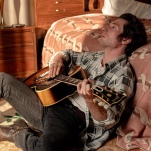From Vanderpump Rules to The Real Housewives, Bravo’s Sobering Portrait of Addiction and Recovery
Nicole Weingart/Bravo
Near the end of the sixth season of Mad Men, Don Draper attempts to stop drinking.
Where does it take him? To the next scene, of course. Don is drinking again before the end of the episode, and when the season culminates in the famous Hershey pitch, his relapse feels preordained. It’s as if Don only gave up drinking so that he could take it up again.
On Mad Men, alcohol was only ever what the plot required it to be. It’s not that Mad Men trivialized problem drinking. There were enough low, pathetic moments to avoid that reduction. But what it did do, so indelibly, was to aestheticize problem drinking. The frosty martinis, the glowing Manhattans, and even all the pain that flowed from the mini-bar in Don’s office—all of it was so damn beautiful.
That’s the thing about fiction: Even when it’s showing us ugliness, fiction can’t help but retranslate it into beauty.
A more recent example comes from Netflix’s Jessica Jones. The eponymous character is a bellicose loner, and so of course she’s always shown swigging from a whiskey bottle. But her hard drinking is never anything more than a stand-in for authentic characterization; it’s a narrative shortcut on par with any other genre trope. Jessica Jones remains a flatly rendered protagonist, no matter her BAC, whose gaps in character are filled with hipflasks and slurred speech.
But whether it’s a matter of the alcoholic aesthetic or merely cheap writing, both characters are part of a long tradition of romanticizing addiction in fiction.
In fiction, addiction functions too often as mere code for “interesting character.” Sometimes that tool works and sometimes it doesn’t. Either way, the formal constraints of fiction often hold the reality of addiction at too remote a distance, keeping us from experiencing the genuinely painful side of addiction, its deeply unattractive nature.
In real life, an untreated drinking problem doesn’t sort itself out. It doesn’t come and go, and it’s not an element of a more compelling character arc. Rather, it variously leaves one humiliated, broke, hospitalized, and after a while, buried.
Addiction has a somewhat different status on reality television. One might even say that reality television offers, well, a more realistic depiction of alcoholism and other forms of substance abuse, compared to those found in traditional forms of storytelling.
Reality television deals with alcohol in a few different ways. In the first category, we have closed-universe shows like Real World and Jersey Shore, in which a group of strangers live together for a finite amount of time. On these shows, alcohol acts as the same social lubricant that we know from our own lives, loosening people up and creating a space for honest chaos. On some shows, its usefulness as a dramatic catalytic is more insidious. For instance, on The Bachelor, the producers are rumored to starve women jittery before serving up the champagne flutes, just to make everyone extra histrionic. On closed-universe reality shows, alcohol is the secret prime mover of all the action, the shows’ trusty élan vital behind all the drama.
The second category involves docuseries dedicated to rehab and recovery sagas, like VH1’s Celebrity Rehab, A&E’s Intervention, and Discovery’s Addicted. Here, addiction appears as an acute crisis, a problem in need of rigorous examination and practical solutions. On these shows, we turn our gaze on human misery, and the result ends up either exploitative or didactic. Here, alcohol is the opposite of what we see on the closed-universe shows. Rather than the covert director of action, alcohol is here an overt catastrophe, taking up the entire frame and subject to intense, continuous focus.
But there is a third category. It seems to me that there’s one area of the reality television landscape where alcohol is depicted just right, and that’s on the open-universe docu-soaps of Bravo.
Unlike closed-universe shows like The Bachelor, and unlike rehab sagas like Celebrity Rehab, the docu-soaps of Bravo show people struggling with alcohol (or coke, or pills, or what have you) while actually embedded in longstanding, dynamic interpersonal networks. The vicissitudes of drinking too much (or too little) are neither central nor marginal. Problem drinking is not the focus, nor is it the prime mover, but rather it appears as an intermittent, interminable trauma, as a pesky recurring intrusion on a functioning social group. To watch someone struggle with alcohol on Bravo is not to relish the disaster, but instead to say over and over, “Please, not this again…”
Recently, the question of alcoholism and addiction has been a central focus of two Bravo shows in particular: Vanderpump Rules and The Real Housewives of Beverly Hills.
On Vanderpump Rules, we see a number of characters dealing with it: Katie, James and Shay. “Tequila Katie” is frequently accused of crossing over into “the dark side” when she drinks. The characterization is particularly intense when it comes from her boyfriend, Tom. Like many drunks, Katie treats Tom like garbage when she’s drinking. But he’s not just a victim. When it’s convenient, he turns her problem drinking against her, sometimes accusing her of simply being drunk instead of taking a moment to acknowledge her real feelings.
Meanwhile, we watched James spend two seasons sinking deeper and deeper into alcoholic misery. All along, there was nothing endearing or cool about James’s problem drinking. Rather, hard drinking turned him into a vile, abusive goblin. During this past season, when James finally started crying and swore off booze entirely, he appeared to mean it. Ironically, just as soon as he quit drinking—and, we might assume, stopped acting like such an asshole—he seemed to drop off the show entirely. It’s a reality that many sober people face: a sober alcoholic’s social life is never, ever the same.
And lastly, we saw the marriage of Scheana and Shay deteriorate precipitously, ever since Shay revealed his pill addiction. Scheana spent two seasons in denial about it, minimizing the issue and convincing herself that the problem was under control. This past season, Scheana had an emblematic moment. She told everyone that she was having communication issues with her husband, but that they went to a therapy session together—one session—and it solved every issue, like magic. A few months later, she finds out he’s using again and files for divorce.
In each of these storylines, all of which are tied into the wider interpersonal narrative, and all of which feature their own complex personal histories, we see how addiction diminishes human emotional life in the shifting context of an ongoing, evolving web of relationships.
But the show with the greatest focus on addiction is The Real Housewives of Beverly Hills. The majority of this season revolved around a longstanding feud between Kim Richards, a recovering addict, and Lisa Rinna, her shameless attacker.
To explain the wide emotional arc of the Kim Richards story would be impossible here. One needs to live through it, as it were, by watching the show from its beginning. But for starters, one can watch the infamous limousine argument between Kim and her sister, Kyle, which remains one of the most notorious moments in all of Real Housewives history.
Watching that old clip, one can tell that there’s nothing funny about Kim’s problem. Nor is it the juicy, fun drama that one stereotypically associates with these shows. Even when Kim gains control and achieves tenuous sobriety in subsequent seasons, coming to understand her suffering does not feel like a rehab featurette. Rather, it’s heartbreaking. All you want for her is to never take a drink again. One roots for her and prays for her in a way that wouldn’t make sense for a fictional character. That’s because she’s a real person, and ultimately her suffering isn’t just another coordinate of narrative pleasure.
This season, things got complicated when Eden Sassoon joined the show. Eden is a recovering alcoholic, and she lost her sister to drug addiction. Recognizing her sensitivity to the issue, Rinna, Kim’s cruel enemy, tells Eden that Kim is not sober, on the edge of death, and that her sister Kyle is an enabler. Upset by this, Eden brings it up with the other women, who fly into a frenzy. Arguments and misunderstandings proliferate, and ultimately Rinna is exposed as the villain. The whole storyline culminates in a big discussion at Kyle’s house, involving multiple sober women struggling to understand one another. The misunderstandings between Eden and Kim show the difficulty that sober people can have relating to each other, and the importance of solidarity among nondrinkers.
I mean it when I say that one can learn things from reality television—real things. The issues of alcoholism, recovery, and the practice of sobriety I’ve sketched out above are only examples. There’s also Adela on Ladies of London, Sonja on Real Housewives of New York City and now Kathryn on Southern Charm. Through these characters, one can learn about interpersonal communication, unintended emotional consequences, and the complexity of living in socio-dynamic structure when life isn’t perfect—all in ways that can’t be learned in traditional forms of storytelling.
The season finale of Real Housewives of Beverly Hills airs tonight at 9 p.m. on Bravo.
Tom Syverson is a writer living in Brooklyn. He can be contacted and harassed on Twitter: @syvology.







































